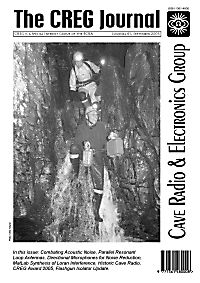
- The most recent issue to be published was 125
- For further information, please see Publishing/Despatch Schedule
- Database last updated on Wed, 03 Apr 2024 16:35:02 +0100
- Online access is currently available for all issues. Some of
the older issues are bit-map scans rather than digital copies.
journal scans.
- Online voting for CREG articles was withdrawn in June 2022. For info see
Voting for CREG articles
Contents of journal 61
September 2005
This page may take a few
seconds to load. Please wait ...
- CREG Journal 61
(PDF 3.6MB)
  Individual articles may be available below Individual articles may be available below
- Contents
-
- Newssheet (3)
- Comment by David Gibson, HeyPhone Coils and PCBs, Diary Dates.
-
- Loran in Northwest Europe (4)
- Loran-C transmissions on 100kHz are responsible for interference to cave radios operating on nearby frequencies. Rob Gill identifies the sites of Northwest European Loran-C transmitters and considers the future of Loran in Europe.
-
- Combating Acoustic Noise (5)
- Mike Bedford considers the extent to which verbal communication is affected by acoustic noise and discusses some avenues for alleviating this interference.
-
- Parallel Resonant Loop Antennas for Cave Radios (6-7)
- Parallel tuned loops are readily compatible with devices designed to operate with earth electrodes. Beat Heeb examines the characteristics of such loops, offers a simple method of tuning, and looks at the effect of loop shape.
-
- Parallel v. Series Resonant Loops (7)
(PDF 333KB)

- David Gibson fills in some of the background to Beat Heeb's article above.
-
- Reducing Acoustic Noise Using Directional Microphones (8-11)
- Communications can be severely disrupted by acoustic noise both on the surface and underground. Mike Bedford considers how the use of directional microphones might overcome this problem.
-
- Noise Cancelling Microphones (11)
- David Gibson attempts to lay to rest some of the myths that surround the term 'noise cancelling' when used to describe pressure gradient microphone capsules for close-talking applications.
-
- Loran Behind the Scenes (12)
- How does Loran work and how does it differ from GPS? Mike Bedford provides a simplified description of how Loran, a hyperbolic navigation system, works.
-
- MatLab Synthesis of Loran Interference (13-15)
- As part of a programme of work to investigate methods of reducing Loran interference to cave radio transmissions, David Gibson describes how to synthesise a test sample using the MatLab software package.
-
- Update: A Flashgun Isolator (16)
- Digital cameras can be damaged by connecting them to a traditional design of electronic flashgun. In this article, David Gibson describes the problem in more detail, and updates his isolator circuit from CREG Journal 60.
-
- CREG Award 2005 (17)
- We issue an annual award to recognize special contributions to the field of cave radio and electronics. David Gibson describes this year's award to Beat Heeb.
-
- Wet and Dry (18)
- Chris Trayner looks at avoiding corrosion, at things it is embarrassing to forget and at ways to keep things dry.
-
- Early Cave Radio in Castleton? (19)
- Chris Trayner uncovered a passage in a 1943 publication by John Royse, describing an early cave radio experiment. He examines the passage in detail and seeks further information.
-
- Radio Tests at Warren Hill Railway Tunnel, Newmarket (20)
- Network Rail had arranged a multi-agency exercise at this location. It had previously been reported that fire service UHF radios did not provide the required range in the 1km tunnel, and John Rabson was asked to investigate.
-
- We Hear (21-22)
- A round-up of news from the world of cave-related radio and electronics. Column edited by Mike Bedford.
-
- Web Watch (22)
- Peter Ludwig brings us another interesting selection of web sites. Online access to the sites mentioned is available from a page kindly provided by Martin Melzer.
-
- Letters to the Editor (23-24)
- HeyPhone Inductors, Cellular Telephone Communications, Audio Phasing Networks and PSK31 in America, Collaborative Cave Radio Development, Time Encoded Speech, News from New Mexico, 'Man's Cave Alarm Drives Intruders Batty', Building HeyPhone PCBs.
-

|

View Contents:

BCRA is a UK registered charity and is a constituent body of
the British Caving Association,
undertaking charitable activities on behalf of the BCA.
BCRA publishes a range of periodicals and books.
Click here for further information.
|
Searching
To Search our pages using Google, type a search
string in the box at the top of the page and hit your Return key
You can also search our publications catalogue at the British Caving Library
The CREG Journal Search Engine is a new, powerful search engine which will, sometime, be extended
to cover Cave & Karst Science. We have a keyword search facility on our Cave Science Indexes pages but this may be rather out-of-date.
|
For staff use: Link to Database
Show/Hide
download figures next to each item (if available and non-zero; you might need to refresh page first). Counters last
reset on Thu 03-Jan-2019 17:29:28 +00:00. The figures are non-unique
click-throughs.
|








